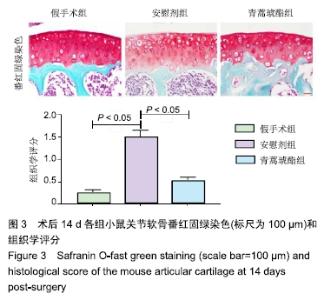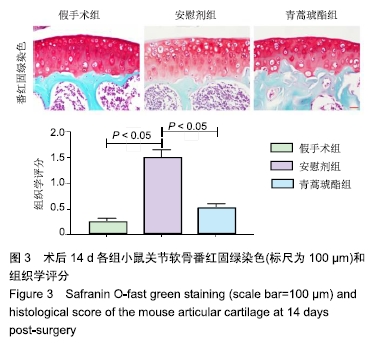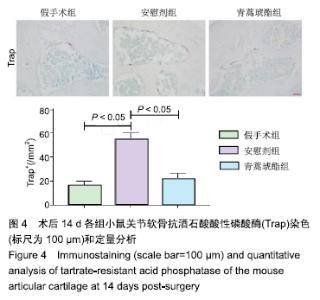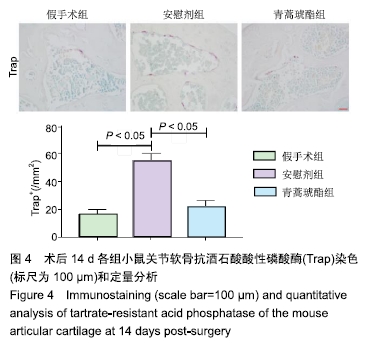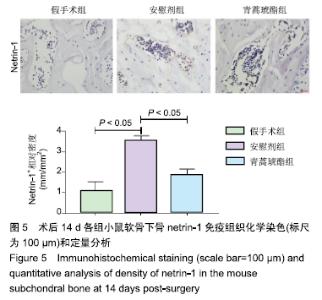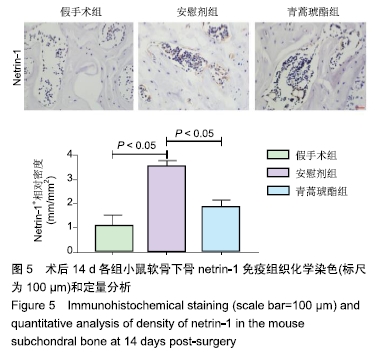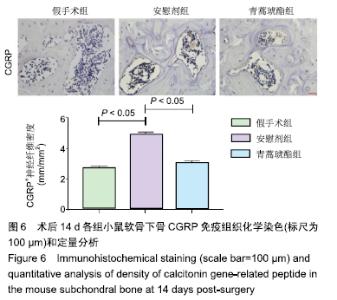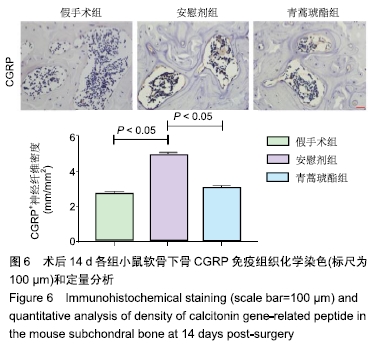Chinese Journal of Tissue Engineering Research ›› 2020, Vol. 24 ›› Issue (17): 2636-2641.doi: 10.3969/j.issn.2095-4344.2672
Previous Articles Next Articles
Artesunate relieves subchondral bone osteoclast-mediated osteoarthritis pain
Shalitanati·Wuermanbieke1, Li Yicheng1, Ren Jiangdong1, Ma Hairong2, Mu Wenbo1, Cao Li3
- 1Department of Joint Surgery, 2Clinical Medical School, 3Department of Orthopedics, First Affiliated Hospital of Xinjiang Uygur Autonomous Region, Urumqi 830054, Xinjiang Uygur Autonomous Region, China
-
Received:2019-10-08Revised:2019-10-10Accepted:2019-11-25Online:2020-06-18Published:2020-03-28 -
Contact:Cao Li, Chief physician, Professor, Department of Joint Surgery, First Affiliated Hospital of Xinjiang Uygur Autonomous Region, Urumqi 830054, Xinjiang Uygur Autonomous Region, China -
About author:Shalitanati•Wuermanbieke, Master candidate, Department of Joint Surgery, First Affiliated Hospital of Xinjiang Uygur Autonomous Region, Urumqi 830054, Xinjiang Uygur Autonomous Region, China -
Supported by:the Joint Fund of the National Natural Science Foundation of China (Major Program), No. U1503221; the Regional Fund of the National Natural Science Foundation of China, No. 81860746
CLC Number:
Cite this article
Shalitanati•Wuermanbieke, Li Yicheng, Ren Jiangdong, Ma Hairong, Mu Wenbo, Cao Li. Artesunate relieves subchondral bone osteoclast-mediated osteoarthritis pain[J]. Chinese Journal of Tissue Engineering Research, 2020, 24(17): 2636-2641.
share this article
| [1] World Health Organization. Chronic Rheumatic Conditions. Available at: http://www.who.int/chp/topics/rheumatic/en/ (accessed 5 September 2018). [2] 邱贵兴,裴福兴,唐佩福,等.骨科常见疼痛管理临床实践指南(2018版)[J].中华骨与关节外科杂志, 2019, 12(3):161-167. [3] O'NEIL CK, HANLON JT, MARCUM ZA. Adverse effects of analgesics commonly used by older adults with osteoarthritis: focus on non-opioid and opioid analgesics. Am J Geriatr Pharmacother. 2012;10(6): 331-342. [4] NELSON AE, ALLEN KD, GOLIGHTLY YM, et al. A systematic review of recommendations and guidelines for the management of osteoarthritis: The chronic osteoarthritis management initiative of the U.S. bone and joint initiative. Semin Arthritis Rheum. 2014;43(6):701-712. [5] BANNURU RR, NATOV NS, OBADAN IE, et al. Therapeutic trajectory of hyaluronic acid versus corticosteroids in the treatment of knee osteoarthritis: a systematic review and meta-analysis. Arthritis Rheum. 2009;61(12):1704-1711. [6] SHETH U, SIMUNOVIC N, KLEIN G, et al. Efficacy of autologous platelet-rich plasma use for orthopaedic indications: a meta-analysis. J Bone Joint Surg Am. 2012;94(4):298-307. [7] CORBETT MS, RICE SJ, MADURASINGHE V, et al. Acupuncture and other physical treatments for the relief of pain due to osteoarthritis of the knee: network meta-analysis. Osteoarthritis Cartilage. 2013;21(9): 1290-1298. [8] WALLER B, OGONOWSKA-SLODOWNIK A, VITOR M, et al. Effect of therapeutic aquatic exercise on symptoms and function associated with lower limb osteoarthritis: systematic review with meta-analysis. Phys Ther. 2014;94(10):1383-1395. [9] ZENG C, LI H, YANG T, et al. Electrical stimulation for pain relief in knee osteoarthritis: systematic review and network meta-analysis. Osteoarthritis Cartilage. 2015;23(2):189-202. [10] 袁义,吴立东,章海均,等.射频热凝术治疗中老年人膝骨性关节炎顽固性疼痛的疗效观察[J].中华老年医学杂志, 2012, 31(12):1097-1099. [11] KONGTHARVONSKUL J, ANOTHAISINTAWEE T, MCEVOY M, et al. Efficacy and safety of glucosamine, diacerein, and NSAIDs in osteoarthritis knee: a systematic review and network meta-analysis. Eur J Med Res. 2015;20:24. [12] BURR DB, GALLANT MA. Bone remodelling in osteoarthritis. Nat Rev Rheumatol. 2012;8(11):665-673. [13] ZHEN G, WEN C, JIA X, et al. Inhibition of TGF-β signaling in mesenchymal stem cells of subchondral bone attenuates osteoarthritis. Nat Med. 2013;19(6):704-712. [14] NWOSU LN, ALLEN M, WYATT L, et al. Pain prediction by serum biomarkers of bone turnover in people with knee osteoarthritis: an observational study of TRAcP5b and cathepsin K in OA. Osteoarthritis Cartilage. 2017;25(6):858-865. [15] STRASSLE BW, MARK L, LEVENTHAL L, et al. Inhibition of osteoclasts prevents cartilage loss and pain in a rat model of degenerative joint disease. Osteoarthritis Cartilage. 2010;18(10): 1319-1328. [16] ZHU S, ZHU J, ZHEN G, et al. Subchondral bone osteoclasts induce sensory innervation and osteoarthritis pain. J Clin Invest. 2019;129(3): 1076-1093. [17] LIU Z, ZHANG J, LI S, et al. Artesunate Inhibits Renal Ischemia Reperfusion-Stimulated Lung Inflammation in Rats by Activating HO-1 Pathway. Inflammation. 2018;41(1):114-121. [18] LU H, WANG B, CUI N, et al. Artesunate suppresses oxidative and inflammatory processes by activating Nrf2 and ROS‑dependent p38 MAPK and protects against cerebral ischemia‑reperfusion injury. Mol Med Rep. 2018;17(5):6639-6646. [19] WEI CM, LIU Q, SONG FM, et al. Artesunate inhibits RANKL-induced osteoclastogenesis and bone resorption in vitro and prevents LPS-induced bone loss in vivo. J Cell Physiol. 2018;233(1):476-485. [20] GLASSON SS, CHAMBERS MG, VAN DEN BERG WB, et al. The OARSI histopathology initiative - recommendations for histological assessments of osteoarthritis in the mouse. Osteoarthritis Cartilage. 2010;18 Suppl 3:S17-23. [21] 吕岩,程建国,樊碧发,等. ICD-11慢性疼痛分类中文编译版[J].中国疼痛医学杂志, 2018, 24(11):801-805. [22] HUNTER DJ, MCDOUGALL JJ, KEEFE FJ. The symptoms of osteoarthritis and the genesis of pain. Med Clin North Am. 2009;93(1): 83-100. [23] ARENDT-NIELSEN L, NIE H, LAURSEN MB, et al. Sensitization in patients with painful knee osteoarthritis. Pain. 2010;149(3):573-581. [24] YUSUF E, KORTEKAAS MC, WATT I, et al. Do knee abnormalities visualised on MRI explain knee pain in knee osteoarthritis? A systematic review. Ann Rheum Dis. 2011;70(1):60-67. [25] KWOH CK. Clinical relevance of bone marrow lesions in OA. Nat Rev Rheumatol. 2013;9(1):7-8. [26] LASLETT LL, DORÉ DA, QUINN SJ, et al. Zoledronic acid reduces knee pain and bone marrow lesions over 1 year: a randomised controlled trial. Ann Rheum Dis. 2012;71(8):1322-1328. [27] XU L, NWOSU LN, BURSTON JJ, et al. The anti-NGF antibody muMab 911 both prevents and reverses pain behaviour and subchondral osteoclast numbers in a rat model of osteoarthritis pain. Osteoarthritis Cartilage. 2016;24(9):1587-1595. [28] CUI Z, CRANE J, XIE H, et al. Halofuginone attenuates osteoarthritis by inhibition of TGF-β activity and H-type vessel formation in subchondral bone. Ann Rheum Dis. 2016;75(9):1714-1721. [29] PARFITT AM, DREZNER MK, GLORIEUX FH, et al. Bone histomorphometry: standardization of nomenclature, symbols, and units. Report of the ASBMR Histomorphometry Nomenclature Committee. J Bone Miner Res. 1987;2(6):595-610. [30] ZENG X, ZHANG Y, WANG S, et al. Artesunate suppresses RANKL-induced osteoclastogenesis through inhibition of PLCγ1-Ca2+-NFATc1 signaling pathway and prevents ovariectomy-induced bone loss. Biochem Pharmacol. 2017;124:57-68. [31] JI B, ZHANG Z, GUO W, et al. Isoliquiritigenin blunts osteoarthritis by inhibition of bone resorption and angiogenesis in subchondral bone. Sci Rep. 2018;8(1):1721. [32] HALLEEN JM. Tartrate-resistant acid phosphatase 5B is a specific and sensitive marker of bone resorption. Anticancer Res. 2003;23(2A): 1027-1029. [33] BONE HG, DEMPSTER DW, EISMAN JA, et al. Erratum to: Odanacatib for the treatment of postmenopausal osteoporosis: development history and design and participant characteristics of LOFT, the Long-Term Odanacatib Fracture Trial. Osteoporos Int. 2015; 26(11):2721. [34] BIVER E. Use of bone turnover markers in clinical practice. Curr Opin Endocrinol Diabetes Obes. 2012;19(6):468-473. [35] XI J, LI Q, LUO X, et al. Celastrol inhibits glucocorticoid‑induced osteoporosis in rat via the PI3K/AKT and Wnt signaling pathways. Mol Med Rep. 2018;18(5):4753-4759. [36] CHEN X, ZHI X, PAN P, et al. Matrine prevents bone loss in ovariectomized mice by inhibiting RANKL-induced osteoclastogenesis. FASEB J. 2017;31(11):4855-4865. [37] JIMENEZ-ANDRADE JM, MANTYH WG, BLOOM AP, et al. Bone cancer pain. Ann N Y Acad Sci. 2010;1198:173-181. [38] MEDIERO A, RAMKHELAWON B, PEREZ-ASO M, et al. Netrin-1 is a critical autocrine/paracrine factor for osteoclast differentiation. J Bone Miner Res. 2015;30(5):837-854. [39] ZHAO C, LIU Q, WANG K. Artesunate attenuates ACLT-induced osteoarthritis by suppressing osteoclastogenesis and aberrant angiogenesis. Biomed Pharmacother. 2017;96:410-416. |
| [1] | Li Dadi, Zhu Liang, Zheng Li, Zhao Fengchao. Correlation of total knee arthroplasty efficacy with satisfaction and personality characteristics [J]. Chinese Journal of Tissue Engineering Research, 2021, 25(9): 1346-1350. |
| [2] | Wei Wei, Li Jian, Huang Linhai, Lan Mindong, Lu Xianwei, Huang Shaodong. Factors affecting fall fear in the first movement of elderly patients after total knee or hip arthroplasty [J]. Chinese Journal of Tissue Engineering Research, 2021, 25(9): 1351-1355. |
| [3] | Lü Zhen, Bai Jinzhu. A prospective study on the application of staged lumbar motion chain rehabilitation based on McKenzie’s technique after lumbar percutaneous transforaminal endoscopic discectomy [J]. Chinese Journal of Tissue Engineering Research, 2021, 25(9): 1398-1403. |
| [4] | Huang Dengcheng, Wang Zhike, Cao Xuewei. Comparison of the short-term efficacy of extracorporeal shock wave therapy for middle-aged and elderly knee osteoarthritis: a meta-analysis [J]. Chinese Journal of Tissue Engineering Research, 2021, 25(9): 1471-1476. |
| [5] | Gao Yan, Zhao Licong, Zhao Hongzeng, Zhu Yuanyuan, Li Jie, Sang Deen. Alteration of low frequency fluctuation amplitude at brain-resting state in patients with chronic discogenic low back pain [J]. Chinese Journal of Tissue Engineering Research, 2021, 25(8): 1160-1165. |
| [6] | Wu Gang, Chen Jianwen, Wang Shilong, Duan Xiaoran, Liu Haijun, Dong Jianfeng. Simple HyProCure subtalar stabilization in treatment of adolescent flexible flatfoot combined with painful accessory navicular bone [J]. Chinese Journal of Tissue Engineering Research, 2021, 25(6): 901-905. |
| [7] | Li Yan, Wang Pei, Deng Donghuan, Yan Wei, Li Lei, Jiang Hongjiang. Electroacupuncture for pain control after total knee arthroplasty: a meta-analysis [J]. Chinese Journal of Tissue Engineering Research, 2021, 25(6): 957-963. |
| [8] | Zhao Zhongyi, Li Yongzhen, Chen Feng, Ji Aiyu. Comparison of total knee arthroplasty and unicompartmental knee arthroplasty in treatment of traumatic osteoarthritis [J]. Chinese Journal of Tissue Engineering Research, 2021, 25(6): 854-859. |
| [9] | Zhang Nianjun, Chen Ru. Analgesic effect of cocktail therapy combined with femoral nerve block on total knee arthroplasty [J]. Chinese Journal of Tissue Engineering Research, 2021, 25(6): 866-872. |
| [10] | Li Quanxi, Shen Yu, Wan Wei, Sun Shanzhi. Changes of abdominal wall mechanics and pain after tension-free inguinal hernia repair with polypropylene mesh [J]. Chinese Journal of Tissue Engineering Research, 2021, 25(4): 548-552. |
| [11] | Wang Xiaofei, Teng Xueren, Cong Linyan, Zhou Xu, Ma Zhenhua. Herbert screw internal fixation for treating adult osteochondritis dissecans of the knees [J]. Chinese Journal of Tissue Engineering Research, 2021, 25(3): 397-402. |
| [12] | Yang Caihui, Liu Qicheng, Dong Ming, Wang Lina, Zuo Meina, Lu Ying, Niu Weidong. Serine/threonine protein kinases can promote bone destruction in mouse models of chronic periapical periodontitis [J]. Chinese Journal of Tissue Engineering Research, 2021, 25(23): 3654-3659. |
| [13] | Yang Wei, Chen Zehua, Yi Zhiyong, Huang Xudong, Han Qingmin, Zhang Ronghua. Effectiveness of intra-articular injection of hyaluronic acid versus placebo in the treatment of early and mid-stage knee osteoarthritis: a Meta-analysis based on randomized, double-blind, controlled, clinical trials [J]. Chinese Journal of Tissue Engineering Research, 2021, 25(23): 3760-3766. |
| [14] | Liu Chang, Li Datong, Liu Yuan, Kong Lingbo, Guo Rui, Yang Lixue, Hao Dingjun, He Baorong. Poor efficacy after vertebral augmentation surgery of acute symptomatic thoracolumbar osteoporotic compression fracture: relationship with bone cement, bone mineral density, and adjacent fractures [J]. Chinese Journal of Tissue Engineering Research, 2021, 25(22): 3510-3516. |
| [15] | Huo Hua, Cheng Yuting, Zhou Qian, Qi Yuhan, Wu Chao, Shi Qianhui, Yang Tongjing, Liao Jian, Hong Wei. Effects of drug coating on implant surface on the osseointegration [J]. Chinese Journal of Tissue Engineering Research, 2021, 25(22): 3558-3564. |
| Viewed | ||||||
|
Full text |
|
|||||
|
Abstract |
|
|||||




